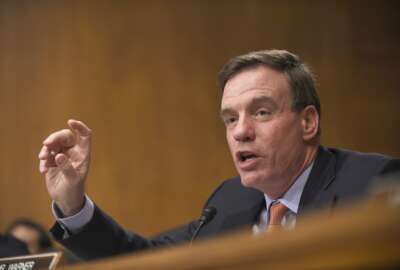
Clinton’s tech policy pledges smarter, newer, more open government
Hillary Clinton's technology and innovation initiative pledges a more modern and open digital government. The policy plan also supports the creation of more STEM...
Promising a more transparent, modern and user-friendly government, Hillary Clinton unveiled her Initiative on Technology and Innovation.
Clinton’s initiative stands on a five-point platform that includes making the “government smarter, more efficient, and more responsive, using new technologies to deliver real results for the American people.”
To make government “smarter and more innovative,” Clinton said she will focus on making it easier to modernize federal IT systems, strengthen cybersecurity and make data easier to access both in and outside the government.
Policy experts on both sides of the aisle say a technology plan is an important part of a candidate’s platform — even if voters don’t realize it — but Clinton’s plan does leave some questions unanswered.
“Everyone’s in favor of more modern IT systems, everyone’s in favor of better government, more efficient government and giving government more technology to get its job done,” said James Gattuso, a regulatory and telecommunications expert at The Heritage Foundation. “But the real question, the hard part, is how do you reach your goals, even with the best equipment in the world. It’s the definition of the goal and getting there, that’s the important part. I think in the past we’ve seen that even the best equipment in the world doesn’t help if your goals aren’t defined and if the government is doing things that are outside its core competence.”
Niam Yaraghi, an expert on economics of healthcare information technology at the Brookings Institution, said the plan looked very comprehensive and to him, “it just contains very good things.”
“That is a little bit alarming, because it contains too many good things,” Yaraghi said. “I’m really not sure how feasible it would be politically and economically to implement those plans.”
A request for comment was not immediately returned by Donald Trump’s press office.
Modernizing and digitizing
Clinton stated in her initiative that government hardware, software and the IT buying process are bulky and outdated, echoing the sentiments of federal CIO Tony Scott.
“The federal government spends nearly $90 billion in information technology but the American taxpayer doesn’t get $90 billion in value,” the initiative states. “Hillary will make it easier for the federal government to find, try, and buy innovative technology — including open source software.”
Clinton’s plan also includes cutting red tape surrounding the IT procurement process, and breaking up large government IT projects into smaller ones so that it’s not only easier to stop them if they run over budget or don’t meet mission, but are more small and medium-sized business friendly.
In her plan, Clinton said she will make the U.S. Digital Service a “permanent priority for federal agencies.”
This includes expanding Digital Service teams throughout the government to “ensure that CIOs are part of this innovation agenda,” the plan states.
She is also tasking USDS with creating a “Yelp for government,” to allow the public to rate agencies on performance and customer service.
“Hillary will charge the USDS with transforming and digitizing the top 25 federal government services that directly serve citizens,” the initiative states.
Cybersecurity and encryption
Along with modernizing the government’s IT systems, Clinton said she will also work on better protections for those systems.
Clinton said she will prioritize enforcing cybersecurity standards, and supports the use of multi-factor authentication and the concept of a national commission on digital security and encryption.
Jim Harper, a senior fellow at the Cato Institute, said he wondered whether Clinton can be both a “cheerleader for the tech business sector” but also “oversee the government’s erosion of its underpinnings.”
“In supporting a ‘national commission on digital security and encryption,’ she endorses a widely agreed upon cop-out. We don’t need to have a commission talk about it,” Harper said in an email to Federal News Radio. “Encryption is an essential protection of privacy, free speech and data security.”
Debate on encryption rights came to a head earlier this year when the FBI demanded Apple unlock an iPhone owned by one of the San Bernardino shooters.
Trump at the time sided with the FBI, while Clinton voiced hope for a balance between opening a Pandora’s Box for hackers but also preventing future terrorist attacks.
Clinton said she also wants to boost the number of cleared “government red teams” to help agencies address vulnerabilities.
“She will encourage government agencies to consider innovative tools like bug bounty programs, modeled on the Defense Department’s recent ‘Hack the Pentagon‘ initiative, to encourage hackers to responsibly disclose vulnerabilities they discover to the government,” the plan states.
Accountability and innovation
Transparency and accountability are also part of Clinton’s cyber initiative. Clinton said she would fully implement the DATA Act and also support an “open data approach to regulation,” which would make “it easier for businesses to submit structured data instead of documents,” and for the government and public to see a company’s financial information.
The DATA Act will standardize the way the government shares its spending information, making it more transparent to other agencies and to the public.
Cato’s Harper said every candidate should support the DATA Act.
“The DATA Act requires agencies to publish spending data in uniform formats government-wide, and its implementation will radically improve the ability of the public to oversee the government,” Harper said.
Clinton also pledged her support for agency performance goals and “data-driven dashboards.”
Clinton said her agenda and priorities would be posted on performance.gov, and progress on these priorities would be regularly updated.
“By promoting this high type of transparency and accountability, and leveraging technology to do so in a real-time manner, citizens will develop greater confidence that their government is working for their common good,” Clinton states in her plan.
STEM and net neutrality
Clinton’s initiative also includes plans to create more jobs in the STEM (science, technology, engineering and math) sector.
Clinton says in her plan she will protect an open internet and states her support for the net neutrality rules passed by the Federal Communications Commission.
In 2014 Trump said net neutrality could result in the targeting of “conservative media,” after President Barack Obama called on the FCC to support the equal treatment of internet traffic.
Trump also said last December he would support “closing that Internet up in some way,” in relation to the Islamic State’s growing online presence.
The ‘middle child’
How important a technology policy will be to voters this election remains to be seen.
Gattuso likened technology to being “the middle child” of public policy.
“I think that it’s actually a positive sign that the Clinton campaign is sort of moving to fill that void, they’ve identified apparently the tech community as something that is important, a train they want to get on board of,” Gattuso said. “I don’t know whether they have the right policies, I don’t know if it would be the ones I would choose, but I think it’s significant that they see the field as significant.”
Yaraghi said when it comes to technology and the government, it’s usually not their top priority unless the combination isn’t working or it directly impacts them, such as the troubled rollout of healthcare.gov.
“Nobody cares how government websites are working unless you need them,” Yaragahi said. “Although they do not directly care about it, the products that are based upon such innovations and initiatives [like data.gov and the push for STEM education] would make a difference in peoples lives. As long as they’re working perfectly, people don’t care. But as soon as they stop working people start talking about it.”
Copyright © 2025 Federal News Network. All rights reserved. This website is not intended for users located within the European Economic Area.





